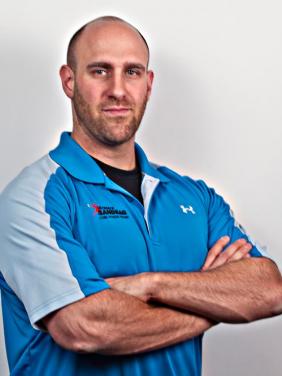In part one of this four-part series, I talked about how hip stiffness is usually part of a larger complex of stiff tissues and joints throughout the body. I then offered a very basic mobilization sequence starting with a knee sit and progressing to a standing hip extension/flexion drill. In this second part of the series, I will discuss more dynamic strategies for opening the hips and hamstrings to produce the active and resilient flexibility needed for sport.
After finishing the initial PCC with Al, Danny, Steven and Adrienne, I had the opportunity to attend the GAIN Conference hosted by Vern Gambetta at Rice University in Houston. This five day event, which started each day at 6:30AM on the Rice track and concluded at 9:30PM at the Valhalla Pub, included lectures and practical sessions hosted by luminaries in Olympic, collegiate and professional athletics.
One of the most inspiring presenters was Jim Radcliffe, Head of Strength and Conditioning at the University of Oregon for the past 28 years. It was immediately obvious that Jimmy was first and foremost a “movement” guy, who happened to be applying his principles in one of the most successful and well-funded athletic departments in the world. He spoke of growing up in northern California where he climbed trees and ran through the woods acquiring strength, mobility and coordination in a natural environment. He then discussed how his strength and conditioning program for Oregon football was based upon the natural movements he grew up with. Jimmy said that probably only 25% of his team’s work is done with weights. And much of the weight work, such as his Good Morning sequence, adds movement into the progressions.
Jimmy’s training template is as follows (in this order): dynamic mobility, “pillars of strength” (reflexive core stability drills), two stations of hip hinging drills, two weight-based stations (usually Olympic-style lifts), and agility work. The athletes do much of this work barefoot, and the agility work is often done in Oregon’s 40-Meter sandpit. Most importantly, Jimmy uses what he calls a “Jet Tempo” in his workouts to mimic the pace that Oregon football has become famous for. He emphasizes that he does no additional “conditioning” work to supplement his workouts. As he wants every rep to be explosive, he has no interest in training kids to do cardio at less than game pace because he doesn’t want to create “slow” neural adaptations.
The video that follows is an adaptation of the dynamic mobility drills Jimmy had us do in one of our practical sessions at GAIN. He said the athletes spend 3-5 minutes max doing this before going on to their reflexive core work. As Pavel demonstrated in Super Joints, Beyond Stretching and Relax into Stretch, athletes need to be flexible in athletic positions. They need mobility/stability under the incredible amount of tension produced by making high-speed cuts and other athletic moves. This sequence is a great way to loosen up the hips and hamstrings to prepare your body for whatever intense workout you may have in store for it.
***
Mark Bixby is a Dragon Door RKC Team Leader, PCC Instructor and MovNat Instructor. He discovered kettlebells in 2002 and found that they are the quickest, most effective way to train. A combination of past injuries and persistent low physical self-image had caused Mark to have severe posture issues and chronic back pain. Kettlebells taught Mark how to use his hips so that he didn’t tuck his pelvis and slump with his posture. He grew taller, stronger and more confident. More than six years later, Mark has accomplished huge gains in strength, flexibility and stability and he finds that kettlebells still present significant physical and technical challenges. Because the skill set can always be refined, kettlebells continue to push Mark towards higher levels of body awareness and fitness. Mark can be reached through: http://www.dkbfitness.com/.


